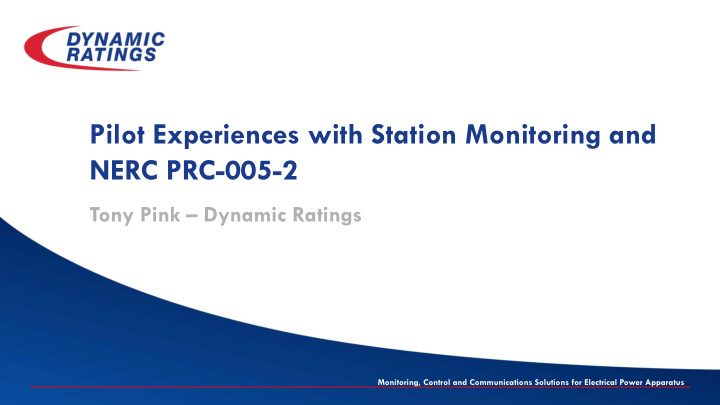



Pilot Experiences with Station Monitoring and NERC PRC-005-2 Tony Pink – Dynamic Ratings Monitoring, Control and Communications Solutions for Electrical Power Apparatus
Why Consider Battery Monitoring ● NERC PRC-005-2 ● NERC Evidence Retention Requirement ● Reduction in Maintenance Budgets ● Personnel Reassignment ● Decline of Specialist Crafts Personnel ● Consistency of Data ● Real-time Information ● Ability to Act in a Timely Manner to Issues Monitoring, Control and Communications Solutions for Electrical Power Apparatus
NERC Definitions Protection System – Station dc supply associated with protective functions (including batteries, battery chargers, and non-battery-based dc supply) PSMP – Protection System Maintenance Program – Includes all batteries associated with the protection system – Batteries must be included in a time-based program Verify — Determine that the component is functioning correctly. Monitor — Observe the routine in-service operation of the component. Monitoring, Control and Communications Solutions for Electrical Power Apparatus
Comparison of Tasks for Vented Lead Acid (VLA) Batteries Non-Monitored Monitored Max Task Max Interval Interval Verify dc supply voltage, 4 calendar Inspect electrolyte levels and for unintentional grounds months Verify battery float voltage, continuity, terminal connection resistance, intercell or unit to unit connection 18 calendar No Periodic resistance months maintenance Inspect cell condition where visible or perform an specified performance by internal ohmic test if not visible 18 calendar Verify Performance by ohmic testing or float current months <or> <or> Perform Load Test 6 calendar years 18 calendar 18 calendar Inspect condition of battery rack months months Monitoring, Control and Communications Solutions for Electrical Power Apparatus
Comparison of Tasks for Valve Regulated Lead Acid (VRLA) Batteries Non-Monitored Monitored Max Task Max Interval Interval Verify dc supply voltage, for unintentional 4 calendar grounds months Inspect condition of individual units by 6 calendar measuring internal ohmic values months No Periodic Verify battery float voltage, continuity, 18 calendar maintenance terminal resistance, intercell or unit to unit months specified connection resistance Verify performance by internal ohmic test or 6 months float current against baseline <or> <or> Load Test 3 calendar years 18 calendar 18 calendar Inspect condition of battery rack months months Monitoring, Control and Communications Solutions for Electrical Power Apparatus
Comparison of Tasks for Nickel Cadmium (NiCd) Batteries Non-Monitored Monitored Max Task Max Interval Interval Verify dc supply voltage 4 calendar Inspect electrolyte level s and for months unintentional grounds No Periodic Verify battery float voltage, continuity, maintenance terminal resistance, intercell or unit to unit specified connection resistance 18 calendar Inspect cell condition of all individual months batteries and physical condition of rack Load Test 6 calendar years 6 calendar years Monitoring, Control and Communications Solutions for Electrical Power Apparatus
Collateral Benefits ● Monitor over Corporate, Non-Secure Network ● Programmable Dry Contacts ● Confirmation of Quality of Ohmic Testing ● Ensure Proper Charging Voltage – THE No. 1 Cause of Battery Failure is Improper Charging ● Ability to Evaluate Battery Manufacturing Quality ● Ability to Remotely Monitor Battery Room or Control Room Temperature ● Interconnection of Other Sensors such as Hydrogen Detectors Monitoring, Control and Communications Solutions for Electrical Power Apparatus
Comparison of Monitor to Handheld Ohmic Test Monitoring, Control and Communications Solutions for Electrical Power Apparatus
Evaluation of Battery Quality Monitoring, Control and Communications Solutions for Electrical Power Apparatus
• Consolidates Data from Battery Monitor • Develops Health Scores of Battery Strings for Ranking Purposes • Identifies • String Status • Charger Status • Individual Cell Status • Provides NERC Report Monitoring, Control and Communications Solutions for Electrical Power Apparatus
Individual Cell Information Statistical Summary Ohmic Values with Upper and Lower Limits and Baseline Values Cell Voltages with Upper and Lower Limits Monitoring, Control and Communications Solutions for Electrical Power Apparatus
Drill Down Into Specific Cell or Jar Sliding Time Scale of Cell Ohmic Values with Upper and Lower Limits and Baseline Values Sliding Time Scale of Cell Voltage with Upper and Lower Monitoring, Control and Communications Solutions for Electrical Power Apparatus
String Information Summary of Major Parameters Monitoring, Control and Communications Solutions for Electrical Power Apparatus
String Information (continued) Multi-Parameter Display including Charging Current, Temperatures and Overall Voltage Monitoring, Control and Communications Solutions for Electrical Power Apparatus
NERC Reporting Monitoring, Control and Communications Solutions for Electrical Power Apparatus
IEEE Standard 1491 IEEE Guide for Selection and Use of Battery Monitoring Equipment in Stationary Applications Monitoring, Control and Communications Solutions for Electrical Power Apparatus
Pilot Experiences with Station Monitoring and NERC PRC-005-2 Monitoring, Control and Communications Solutions for Electrical Power Apparatus
References ● NERC PRC-005-2, adopted November 7, 2012 ● NERC Glossary of Terms Used in NERC Reliability Standards, updated February 11, 2013 ● NERC Protection System Maintenance, A Technical Reference, September 13, 2007 ● IEEE Std 1491, IEEE Guide for Selection and Use of Battery Monitoring Equipment in Stationary Applications ● IEEE Std 450, IEEE Recommended Practice for Maintenance, Testing and Replacement of Vented Lead-Acid Batteries for Stationary Applications ● IEEE Std 1106, IEEE Recommended Practice for Maintenance, Testing and Replacement of Vented Nickel-Cadmium Batteries for Stationary Applications ● IEEE Std 1187, IEEE Recommended Practice for Maintenance, Testing and Replacement of Valve-Regulated Lead-Acid Batteries for Stationary Applications Monitoring, Control and Communications Solutions for Electrical Power Apparatus
Recommend
More recommend